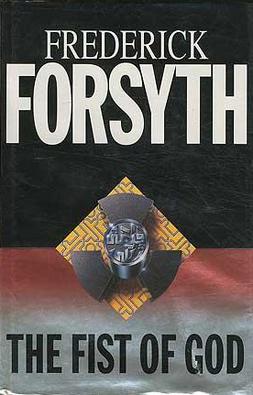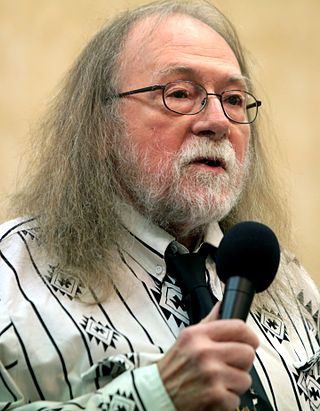
Nuclear winter is a severe and prolonged global climatic cooling effect that is hypothesized to occur after widespread firestorms following a large-scale nuclear war. The hypothesis is based on the fact that such fires can inject soot into the stratosphere, where it can block some direct sunlight from reaching the surface of the Earth. It is speculated that the resulting cooling would lead to widespread crop failure and famine. When developing computer models of nuclear-winter scenarios, researchers use the conventional bombing of Hamburg, and the Hiroshima firestorm in World War II as example cases where soot might have been injected into the stratosphere, alongside modern observations of natural, large-area wildfire-firestorms.

Nuclear warfare, also known as atomic warfare, is a military conflict or prepared political strategy that deploys nuclear weaponry. Nuclear weapons are weapons of mass destruction; in contrast to conventional warfare, nuclear warfare can produce destruction in a much shorter time and can have a long-lasting radiological result. A major nuclear exchange would likely have long-term effects, primarily from the fallout released, and could also lead to secondary effects, such as "nuclear winter", nuclear famine, and societal collapse. A global thermonuclear war with Cold War-era stockpiles, or even with the current smaller stockpiles, may lead to various scenarios including the human extinction.

Fail Safe is a 1964 Cold War thriller film directed by Sidney Lumet, based on the 1962 novel of the same name by Eugene Burdick and Harvey Wheeler. The film follows a crisis caused by a critical error that sends a group of U.S. bombers to destroy Moscow, and the ensuing attempts to stop the bomber group before it can deploy a nuclear first strike. The film features performances by actors Henry Fonda, Dan O'Herlihy, Walter Matthau, Frank Overton, Fritz Weaver, Edward Binns, Larry Hagman, Sorrell Booke, Dana Elcar and Dom DeLuise.

A nuclear and radiation accident is defined by the International Atomic Energy Agency (IAEA) as "an event that has led to significant consequences to people, the environment or the facility." Examples include lethal effects to individuals, large radioactivity release to the environment, or a reactor core melt. The prime example of a "major nuclear accident" is one in which a reactor core is damaged and significant amounts of radioactive isotopes are released, such as in the Chernobyl disaster in 1986 and Fukushima nuclear disaster in 2011.

The nuclear arms race was an arms race competition for supremacy in nuclear warfare between the United States, the Soviet Union, and their respective allies during the Cold War. During this same period, in addition to the American and Soviet nuclear stockpiles, other countries developed nuclear weapons, though no other country engaged in warhead production on nearly the same scale as the two superpowers.

The Fist of God is a 1994 suspense novel by British writer Frederick Forsyth, with a fictitious retelling of the Iraqi Project Babylon and the resulting "supergun".

The Soviet atomic bomb project was the classified research and development program that was authorized by Joseph Stalin in the Soviet Union to develop nuclear weapons during and after World War II.

The United States was the first country to manufacture nuclear weapons and is the only country to have used them in combat, with the bombings of Hiroshima and Nagasaki in World War II. Before and during the Cold War, it conducted 1,054 nuclear tests, and tested many long-range nuclear weapons delivery systems.

Destination Unknown is a work of spy fiction by Agatha Christie and first published in the UK by the Collins Crime Club on 1 November 1954 and in US by Dodd, Mead and Company in 1955 under the title of So Many Steps to Death. The UK edition retailed at ten shillings and sixpence (10/6) and the US edition at $2.75.

Edward Winslow Bryant Jr. was an American science fiction and horror writer sometimes associated with the Dangerous Visions series of anthologies that bolstered The New Wave. At the time of his death, he resided in North Denver.

Atomic spies or atom spies were people in the United States, the United Kingdom, and Canada who are known to have illicitly given information about nuclear weapons production or design to the Soviet Union during World War II and the early Cold War. Exactly what was given, and whether everyone on the list gave it, are still matters of some scholarly dispute. In some cases, some of the arrested suspects or government witnesses had given strong testimonies or confessions which they recanted later or said were fabricated. Their work constitutes the most publicly well-known and well-documented case of nuclear espionage in the history of nuclear weapons. At the same time, numerous nuclear scientists wanted to share the information with the world scientific community, but this proposal was firmly quashed by the United States government.

The Negotiator is a crime novel by English writer Frederick Forsyth, first published in 1989. The story includes a number of threads that are slowly woven together. The central thread concerns a kidnapping that turns into a murder and the negotiator's attempts to solve the crime.
Alan Rodgers was a science fiction and horror writer, editor, and poet. In the mid-eighties he was the editor for Night Cry. His short stories have been published in a number of venues, including Weird Tales, Twilight Zone and a number of anthologies, such as Darker Masques, Prom Night, and Vengeance Fantastic. His novelette "The Boy Who Came Back from the Dead" won the Bram Stoker Award for Best Long Fiction in 1987 and was nominated for the World Fantasy Award.

The War in 2020 is a 1991 war-adventure novel written by Ralph Peters. Taking place in a future dystopia, the novel's plot is spread over 15 years and mostly features the United States' efforts to defend the Soviet Union against an alliance of Japan, South Africa, and the Arab Islamic Union, a confederation of militant Islamic states. The novel follows the career of U.S. Army air cavalry officer George Taylor as he leads his troopers in wars abroad and civil conflict at home.
Clay Drewry Blair Jr. was an American journalist and author, best known for his books on military history. Blair wrote some two dozen history books and hundreds of magazine articles that reached a popular audience.

Atomic tourism or nuclear tourism is a form of tourism in which visitors witness nuclear tests or learn about the Atomic Age by traveling to significant sites in atomic history such as nuclear test reactors, museums with nuclear weapon artifacts, delivery vehicles, sites where atomic weapons were detonated, and nuclear power plants.
The United States biological weapons program officially began in spring 1943 on orders from U.S. President Franklin D. Roosevelt. Research continued following World War II as the U.S. built up a large stockpile of biological agents and weapons. Over the course of its 27-year history, the program weaponized and stockpiled seven bio-agents — Bacillus anthracis (anthrax), Francisella tularensis (tularemia), Brucella spp (brucellosis), Coxiella burnetii (Q-fever), Venezuelan equine encephalitis virus, Botulinum toxin (botulism), and Staphylococcal enterotoxin B. The US also pursued basic research on many more bio-agents. Throughout its history, the U.S. bioweapons program was secret. It was later revealed that laboratory and field testing had been common. The official policy of the United States was first to deter the use of bio-weapons against U.S. forces and secondarily to retaliate if deterrence failed.

David L. Robbins is an American author of several historical fiction novels, and a co-founder of the James River Writers. He founded the Richmond-based Podium Foundation.
Biological warfare (BW)—also known as bacteriological warfare, or germ warfare—has had a presence in popular culture for over 100 years. Public interest in it became intense during the Cold War, especially the 1960s and '70s, and continues unabated. This article comprises a list of popular culture works referencing BW or bioterrorism, but not those pertaining to natural, or unintentional, epidemics.














